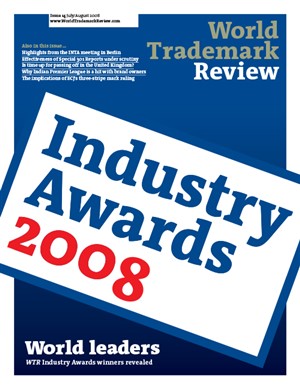-
News & Analysis
-
-
- Categories
- News & Analysis
- Legal Updates
- Long Reads
- Opinion
-
-
- Reports
- Data & Tools
-
Rankings
-
-
- WTR 1000
- Introduction
- All firms
- All individuals
-
- WTR 300
- Introduction
- Individual rankings
-
- Law firm leaders
- EUIPO Filing Elite
- The Global IP Awards
- WTR Global Leaders
-
- WTR Analytics
- WTR 1000 Analytics
-
-
-
Insight
-
-
- Insight
- Guides
- Reviews
- Market Insight
-
-
-
Events
-
-
- Events
- WTR Events
- Diary
-
-
-
- Login | Register

![]()
WTR 14
Branding in India spiced up by Indian Premier League
Cricket has something approaching religious status in India and is easily the nation’s most popular sport. The recent creation of the Indian Premier League could open doors for brand owners looking to enter the booming consumer market
Mustafa Safiyuddin and Shailendra Bhandare
Download
Columns
The view onlineHow UDRP panels address the use of privacy services
Domain registrants often use privacy services legitimately to protect their privacy and/or deceptively to shield their identity from mark owners whose rights they infringe. Use of privacy services is affecting domain name dispute decisions and leading to debates about who is the proper respondent to a complaint
Brands from the frontlineDuPont model may offer business solutions
The structure and organization of DuPont pose IP protection and enforcement challenges. The recent creation of a brandprotection centre is helping the business to meet these challenges and may provide inspiration for other brand owners
Trademark managementRe-filing to cure invalidity essential to trademark audits
An assessment as to vulnerability of a mark to fraud or to non-use cancellation should be part of every rights holder’strademark audit. One of the most effective remedies when such marks are found is re-registration
Counterfeiting perspectivesInfrastructure – and budget – are the keys to combating counterfeiting
It is tempting for brand owners not to take action against counterfeiters if they are unlikely to win damages. However, a little money spent now on brand protection will translate into substantial savings in the long term and help sustain what should always remain at the forefront of any brand owner’s mind – that is, brand equity
Features
Moving on from passing off
The misappropriation of goodwill has traditionallybeen defended in the United Kingdom through actionsfor passing off. But as such claims are notoriously hardto prove, many argue that it is time for the country toconsider adopting a codified unfair competition law
Public interest versus trademark protection
The public interest has often been discussed inrelation to trademark protection in the EuropeanUnion. The ECJ’s recent decision in a case involvingadidas and its well-known three-stripe mark shedssome light on the issue
Industry Awards 2008
On May 20 2008 World Trademark Review announced the winners of its second Industry Awards for in-house trademark counsel at a ceremony in Berlin. The awards are designed to recognize the vitally important work done byin-house trademark counsel, and identify the teams and individuals that are performing their functions to the highest possible standards. The following pages feature profilesof the winners
Best of Berlin
The International Trademark Association’s (INTA) annualmeeting is still the most important event in the trademark community’s calendar. Taking the famous wall of its host city as inspiration, the theme for the 130th annual meeting in Berlinthis year was ‘breaking down barriers’, with a focus on crossborder and cross-discipline issues. In this section,World Trademark Review looks at some of the highlights of the conference
The case for the Special 301 Reports
The US government has published Special 301 Reportsevery spring for nearly 20 years. While their publicationinvariably attracts both attention and outcry from thecountries featured in them, the effectiveness of thereports has also been called into question
Awards night
Over 100 senior trademark professionals attended thesecond World Trademark Review Industry Awards(www.Industry-Awards.com) at the stylish Hotel de Romein Berlin. The following brand owners were represented:Adam Opel, Allianz, Amazon, Anheuser-Busch, Apple, Bayer,Beiersdorf, BP, Cadbury Schweppes, Diageo, DuPont, eBay,ExxonMobil, Federación Nacional de Cafeteros de Colombia,General Electric, GlaxoSmithKline, Google, Gucci, Harley-Davidson, Honeywell International, Intel, Johnson& Johnson, Mars, Microsoft, Nestlé, News Corp, Nokia,Pepsico, Petrobras, Philips, Procter & Gamble, Richemont,Sanofi-Aventis, The Coca-Cola Company, TimeWarner, Total,UBS, Viacom and Yamaha
News
Country correspondent
Design and trade dress
Trade dress can be registered in China as trademarks or design patents. It is more commonly protected under the Anti-unfair Competition Law. However, enforcing rights under that statute may prove to be a higher hurdle to negotiate than enforcing registered rights as it requires evidence that the trade dress is unique and applies to a famous commodity
Design and trade dress
Trade dress law is protected under common law principles in India. Recent case law has addressed some important issues, but divisions remain
Design and trade dress
As in most jurisdictions, the appearance of a product may be protected in Germany under various IP laws and unfair competition law. The courts, in particular the Supreme Court, have developed extensive case law in relation to trade dress protection
Design and trade dress
While trade dress is not recognized as such by Italian law, the appearance of a product may be protected under trademark law, model and design law, copyright law and unfair competition law
Design and trade dress
Mexican law provides protection to designs used as trade dress for both products and services by virtue of industrial design, copyright, trademark or unfair competition law
Design and trade dress
Protection for designs and trade dress in the European Union is possible through various means. This article looks at the key systems available and highlights the benefits of each
Unlock unlimited access to all WTR content